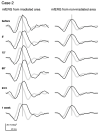Transient Increase and Delay of Multifocal Electroretinograms Following Laser Photocoagulations for Diabetic Macular Edema
- PMID: 33477886
- PMCID: PMC7833362
- DOI: 10.3390/jcm10020357
Transient Increase and Delay of Multifocal Electroretinograms Following Laser Photocoagulations for Diabetic Macular Edema
Abstract
Background: The acute physiological changes induced by focal retinal photocoagulation (PC) have been largely unexplored.
Methods: This was a case-series study. We recorded multifocal electroretinograms (mfERGs) just before PC, and mfERGs were also recorded 5', 15', one hour, 24 h, and one week after the PCs. Transient changes of mfERGs were analyzed in eyes which underwent PCs to treat diabetic macular edema. The mfERGs recorded from the predominantly irradiated area and that from non-irradiated areas were analyzed separately.
Results: Fifteen eyes of 15 patients were included in this study. The mfERGs elicited from non-irradiated areas did not change after PC, but the mfERGs elicited from the irradiated area changed with time; the amplitude was larger at 60' than that before (p < 0.05) and at 5' after PC (p < 0.01) and significantly smaller at 24 h and 1 week than that before and at 60' after the PC (p < 0.01). The implicit time was significantly prolonged after PC. mfERG on irradiated area with the severe diabetic change was less altered after PCs.
Conclusions: The transient increase in the amplitude at 60' likely resulted from a biological amplification of partially damaged cells adjacent to the PC spots. The mfERGs manifested the dynamic alterations of the retinal function following PCs.
Keywords: diabetic macular edema; diabetic retinopathy; electroretinogram (ERG); multifocal electroretinogram (mfERG); photocoagulation.
Conflict of interest statement
The authors declare no conflict of interest.
Figures




References
-
- Moschos M. ERG and VER findings after laser photocoagulation of the retina. Metab. Pediatr. Syst. Ophthalmol. 1982;6:101–105. - PubMed
LinkOut - more resources
Full Text Sources
Other Literature Sources

